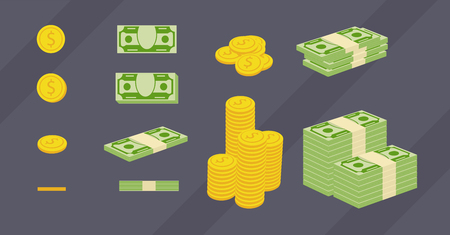Introduction to the Home Buying Journey in the U.S.
For millions of Americans, buying a home is more than just a milestone—its a cornerstone of financial independence and long-term security. However, one of the biggest hurdles on this journey is saving for a house down payment. With rising home prices, higher interest rates, and the increasing cost of living across the country, setting aside enough cash for that initial payment can feel overwhelming. Many people face the challenge of juggling rent, student loans, daily expenses, and unexpected costs while trying to build up their savings. This makes reaching the typical 10% to 20% down payment goal seem almost out of reach for first-time buyers. Thankfully, innovative financial tools and apps designed specifically for Americans are making it easier to plan, track, and grow your savings—turning what once seemed impossible into an achievable reality. In this article, we’ll explore how these digital solutions are changing the game for anyone dreaming of owning a home in the U.S.
2. Key Financial Tools That Simplify Saving
Saving for a house down payment in America can feel overwhelming, but choosing the right financial tools can make the process more straightforward and rewarding. Understanding your options—and leveraging accounts that maximize your savings—puts you ahead of the game. Here are some of the most popular and practical financial tools used by American homebuyers to build their down payment funds:
High-Yield Savings Accounts
A high-yield savings account is one of the easiest ways to grow your money safely while keeping it accessible. These accounts, commonly offered by online banks, offer interest rates significantly higher than those at traditional brick-and-mortar institutions. With no risk to your principal, high-yield savings accounts allow you to earn more with every dollar saved—all while enjoying FDIC insurance protection.
Certificates of Deposit (CDs)
If you can set aside a portion of your down payment fund for a fixed period, certificates of deposit (CDs) are an excellent choice. CDs generally offer even higher interest rates than savings accounts in exchange for locking up your funds for a predetermined term, typically ranging from 6 months to 5 years. This encourages discipline by reducing the temptation to dip into your savings prematurely.
Comparison Table: Savings Tools for Down Payments
| Tool | Interest Rate (Approx.) | Liquidity | FDIC Insured? | Best For |
|---|---|---|---|---|
| High-Yield Savings Account | 4-5% APY | Very High (withdraw anytime) | Yes | Flexible saving, emergency access |
| Certificate of Deposit (CD) | 4.5-5.5% APY | Low (fixed term) | Yes | Savings not needed immediately |
| Money Market Account | 3-4% APY | High (limited checks/debits) | Yes | Larger balances, check-writing needs |
| Automated Savings Apps | N/A or variable based on linked account | Very High (app controlled) | No (but linked account may be FDIC insured) | Savers who want automation & tracking features |
Other Useful Tools: Money Market Accounts & Automated Savings Apps
Money market accounts blend features from both savings and checking accounts, often providing higher interest rates with limited check-writing capabilities—a great fit if you want flexibility without sacrificing growth. Meanwhile, automated savings apps like Qapital or Digit help Americans save effortlessly by rounding up purchases or transferring small amounts automatically into a separate account dedicated to your home goal. These digital tools keep you on track, making saving less about willpower and more about smart systems.

3. Top Savings and Budgeting Apps for Aspiring Homeowners
When it comes to saving for a house down payment in America, having the right financial tools can make all the difference. Thankfully, there are several popular mobile apps and digital platforms designed specifically to help you track your spending, build better money habits, and reach your savings goals faster.
Mint: All-in-One Financial Tracker
Mint is a favorite among Americans looking to get a clear picture of their finances. This free app automatically syncs with your bank accounts, credit cards, loans, and investments, allowing you to see all your transactions in one place. With Mint, you can set customized savings goals—like buying your first home—and the app will help you monitor your progress every step of the way. Mint also alerts you about upcoming bills or unusual spending so you can stay on top of your budget.
YNAB (You Need A Budget): Proactive Budgeting
YNAB is another top choice for those serious about saving for big milestones like a house down payment. Unlike traditional budgeting apps, YNAB encourages you to give every dollar a job and plan ahead for expenses. The platform offers hands-on guidance, workshops, and goal-tracking features that teach users how to break the paycheck-to-paycheck cycle. While YNAB comes with a subscription fee after the free trial, many users find that the accountability and clarity it brings are well worth the investment.
Other Noteworthy Apps
Besides Mint and YNAB, other apps like Personal Capital (great for tracking both spending and investments), Qapital (which automates savings based on personalized rules), and Digit (which analyzes your spending patterns and transfers small amounts into savings) are gaining traction among future homeowners. Each app offers unique features tailored to different financial personalities and needs.
Choosing What Works for You
The key is finding an app or platform that fits seamlessly into your lifestyle. Whether you prefer automated tools or hands-on budgeting, these digital solutions empower you to take control of your finances and get closer to owning your dream home in America.
4. Automated Saving Strategies
One of the biggest hurdles for Americans saving for a house down payment is staying consistent with their savings. Fortunately, many financial tools and apps now offer automated saving features that make this process much easier. These strategies take the guesswork and willpower out of saving by putting your goals on autopilot.
Auto-Transfers: Set It and Forget It
Many banks and financial apps allow you to set up automatic transfers from your checking account to a dedicated savings account. You can choose the amount and frequency—weekly, bi-weekly, or monthly—based on your budget. This method ensures that you’re always making progress toward your down payment without having to remember each month.
Round-Up Features: Save Your Spare Change
Apps like Acorns and Chime offer round-up features that automatically round up every purchase you make to the nearest dollar and transfer the difference into your savings. Over time, these small amounts add up surprisingly fast, turning everyday spending into extra savings for your future home.
Paycheck Deductions: Pay Yourself First
If your employer allows it, you can arrange to have a portion of your paycheck deposited directly into a savings account earmarked for your down payment. This “pay yourself first” approach means you’re less likely to spend what you never see in your main account.
Comparison of Automated Saving Features
| Strategy | How It Works | Best For |
|---|---|---|
| Auto-Transfers | Automatically moves a fixed amount from checking to savings on a set schedule | People who want predictable, steady savings growth |
| Round-Ups | Rounds up each purchase to the nearest dollar and saves the difference | Those who prefer effortless, incremental savings |
| Paycheck Deductions | Sends a portion of each paycheck directly to savings before it hits checking | Anyone looking for disciplined, hands-off saving |
No matter which strategy you choose—or if you combine several—these automated tools help you stay on track with less effort. They are especially effective in the American context, where busy lifestyles and competing expenses can make consistent saving a challenge. By leveraging automation, you’re setting yourself up for success as you work toward your dream home.
5. Real-Life Success Stories from American Savers
Sometimes, the best inspiration comes from real people who have walked the path before you. Across America, first-time homebuyers are turning to financial tools and apps to make their dreams of homeownership a reality. Here are a few stories that showcase how these digital resources have made saving for a house down payment more achievable than ever.
The Young Couple Who Automated Their Savings
Jessica and Mark from Austin, Texas, were determined to buy their first home within three years. Using an app like Qapital, they set up automatic transfers every payday into a dedicated down payment fund. By rounding up their everyday purchases and adding “if this then that” savings rules, they effortlessly saved over $12,000 in just two years — without feeling deprived.
The Solo Saver Who Gamified Her Progress
Maria, a nurse in Chicago, struggled to stay motivated with traditional budgeting. After downloading Digit, she let the app analyze her spending patterns and automatically save small amounts daily. Maria loved watching her progress bar grow and celebrated each milestone with friends. Eighteen months later, she reached her $8,000 goal and was ready for her starter condo.
The Family That Used Shared Goals
The Robinson family in Seattle wanted to involve their teenage kids in the journey to homeownership. They chose YNAB (You Need A Budget), which allowed them to track shared goals and visualize how every dollar helped bring them closer to a new house. Not only did they hit their target faster than expected, but they also taught their kids valuable financial lessons along the way.
These success stories show that with the right financial tools and apps tailored for American savers, building a down payment fund is not just possible — it’s practical and empowering. Whether you’re saving solo or as a family, there’s a solution out there that can help turn your home-buying dreams into reality.
6. Tips for Staying Motivated and Reaching Your Goal
Set Clear, Achievable Milestones
Breaking down your savings goal into smaller, manageable milestones can make the process less overwhelming and more rewarding. For example, if your target down payment is $40,000, set monthly or quarterly targets using your chosen financial app’s goal-tracking features. Celebrate each milestone—whether that’s treating yourself to a movie night or simply acknowledging your progress in the app. This helps maintain momentum and keeps your homeownership dream front of mind.
Automate Your Savings
Take advantage of automation tools offered by apps like Chime, Qapital, or Mint. Setting up automatic transfers to your dedicated savings account ensures you consistently contribute without thinking twice. Automating eliminates the temptation to spend first and save later, which is a common pitfall in American consumer culture.
Visualize Your Progress
Many financial tools provide visual trackers, charts, and even gamified experiences to help you see how far you’ve come. Regularly check these visuals in your app dashboard—it’s motivating to watch your savings grow over time. Some apps let you upload photos of your dream home or neighborhood as a daily reminder of what you’re working toward.
Create Accountability
Share your goal with trusted friends or family members, or join online communities for aspiring homeowners. Apps like Digit and Acorns have social features where users can encourage each other. Knowing others are rooting for you—or even saving alongside you—can boost your commitment during tough months.
Adjust as Life Changes
Your financial journey isn’t always linear. If you experience a job change, unexpected expense, or windfall (like a bonus), use your app’s budgeting tools to reassess and adjust your plan. Flexibility is key—being able to adapt while staying focused on the big picture will keep you motivated through ups and downs.
Reward Yourself Responsibly
Recognize your discipline! When you hit a major milestone or reach a new percentage of your goal, reward yourself with something small yet meaningful—a favorite meal, a new book, or an experience rather than material goods. This balances motivation with responsible spending and keeps the journey enjoyable.
Staying motivated on the path to homeownership takes intention and consistency. Leveraging the right financial tools and apps not only simplifies the process but also empowers you to stay engaged every step of the way. Keep your eye on the prize: that moment when you finally unlock the door to your own home.


